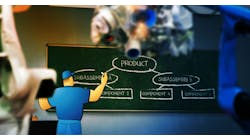Chrysler Uses 3-D to Make Powertrain Manufacturing Safer, More Efficient
In the midst of an epic revival, Chrysler Group LLC has been launching new vehicles, engines and transmissions at a furious pace.
The automaker has turned to 3-D modeling software to help its manufacturing operations keep up -- safely and cost-effectively.
The software enables Chrysler to assimilate the principles of its continuous-improvement methodology -- World Class Manufacturing, or WCM -- early on in the planning process, Chrysler powertrain-manufacturing executive Brian Harlow explained Monday.
"Basically we have a more proactive form of WCM," Harlow told attendees of the Center for Automotive Research's Management Briefing Seminars in Traverse City, Mich. "We're able to do kaizens to make improvements related to our [WCM focus areas] even before any equipment arrives at the plant."
Using the 3-D software, Chrysler can design manufacturing processes that are safer and more ergonomically friendly for operators.
For example, WCM calls for operators to receive parts and components in the "golden zone," a 60-degree window that is comfortable for operators and minimizes non-value-added walking.
"With 3-D, before production ever begins, we're able to determine where racks and materials have to be for every operator in order to bring parts to the golden zone," Harlow said.
Harlow estimates that the automaker now can conduct 90% to 95% of its job-safety risk analyses "in the virtual world."
Powertrain Driving 3-D Adoption
Harlow, who is Chrysler's vice president of NAFTA powertrain operations and global powertrain manufacturing engineering, asserted that "speed and flexibility have been key ingredients in Chrysler's comeback."
He noted that the automaker launched 16 new or "significantly refreshed" vehicles in just 19 months after its rebirth in June 2009.
"We've had to transform our powertrain lineup fast, especially in light of consumer demand and coming regulations related to fuel economy," Harlow said.
That kind of urgency has been driving Chrysler's use of 3-D modeling technology.
For example, the automaker currently is "in a fast turnaround mode" to build a new eight-speed rear-wheel-drive and nine-speed front-wheel-drive transmission at its Kokoma, Ind., plants, he explained.
"We knew we needed a new way of working in order to get our plants in Kokomo ready at an accelerated pace," Harlow said. "By using 3-D technology, we are in effect injecting the principles of WCM from the very beginning of our planning for production startups such as the ones in Kokomo."
The 3-D modeling system, made by Auburn Hills, Mich.-based Strategic Manufacturing Solutions LLC, is designed to enable engineers in powertrain manufacturing to see the shop floor as it really is.
That's a departure from past practices of using 2-D CAD drawings to design, equip and lay out production-line sequencing for a factory, Harlow noted.
"With a two-dimensional drawing, you had to imagine the third dimension," Harlow said. "Engineers have good imaginations, but those imaginations don't all work the same. If you have 10 engineers looking at a 2-D drawing, they will all see it a little differently."
Not Just for Engineers
With a 3-D view of the manufacturing equipment, materials and operators, it's possible to spot potential production and safety issues prior to launch.
"We can begin to look at the line in individual operator stations as they really appear, and we can begin to ask questions like, 'Is this the right amount of room for the equipment operator? Is anything interfering with operations? Are there safety issues? Can the area be compressed to make the line shorter? Will it be easy to maintain the equipment?'"
The automaker is planning to implement the 3-D software at Chrysler and Fiat powertrain plants throughout the world, Harlow noted, and is looking at how its assembly and stamping operations could benefit from it as well.
Harlow sees the software's value extending beyond engineering.
"As we go forward with this software, I foresee the people on the plant floor becoming even more involved in the process of planning their workstations," Harlow said. "Operators are not used to looking at two-dimensional drawings. But when they come in and look at something in three dimensions, it looks like their real world, and they can start giving their input immediately.
"We see a lot of enthusiasm for this approach at the plant level."
Validating Cycle Times
Another benefit of the 3-D software is that it can show an exploded view of a machine. By virtually de-contenting the machine, an operator can see all of the nuts and bolts, making it easier to understand how it goes together, maintain and repair.
"This can be especially useful as we take production into new markets where initially workers might not have the same diagnostic experience and skills," Harlow said.
Through animation, the 3-D software also enables engineers to validate cycle times and "discover system-related issues even before the machinery is made."
"We can see the speed at which parts come down to the conveyor," Harlow told attendees. "We can see the robots turn, grip and rotate. Everything we're looking at is a replication of how the line will be running at the cycle time for which we are designing our machinery.
"If there is a situation anywhere that compromises production, we can identify it up front in the process -- something we ordinarily wouldn't know until the first day of production."



